Best Dog Training Collars & Harnesses: Quick Picks
- Ruffwear Front Range [Best Overall Harness]. This beloved multi-use harness features front and back clips, reflective stitching, ample chest padding, and a sturdy, durable design that makes it popular with hikers.
- Wolfgang Man and Beast [Best Collar Overall] These beautifully-designed dog collars boast creative patterns while rocking sturdy hardware you can rely on. Plus, you can get 10% off when you use code K9OFMINE10 at checkout!
- 2Hounds Freedom No Pull Harness [Best Harness for Pullers]. A fantastic no-pull harness with front and back leash connections. Available in a variety of colors and has several adjustment points.
- SureFit Harness [Best for Awkwardly-Sized Dogs] If your dog boasts a more unique shape (we’re looking at you whippets and greyhounds), the SureFit may be your best bet. It boasts five size adjustment points along with a front and back clip option.
Training your dog well can be challenging, but having the right gear will make it immensely easier and less frustrating.
We’ve already talked about the best treats for training (spoiler alert: the smellier, the better). The type of collar or harness you use during training also warrant careful consideration. We’ll help you out by covering some of the best picks here!
The good news is that you don’t have to spend hours reading product reviews and speaking to salespeople.
Instead, you can check out the top collars and harnesses for training your dog, recommended by some of the best animal behavior consultants in the country.
There’s no denying that they know their stuff, so any of their picks (which we’ll detail below) are sure to get you off to a good start.
We do not recommend prong, choke, or e-collars for training. This tools have been shown to increase stress in dogs and damage your dog’s bond with you. Instead, try these better options below!
A Certified Dog Trainer’s Guide to the Best Collars & Harnesses for Dog Training
Below, we’ve picked out our favorite collars and harnesses to help you control your dog. We’ve also selected our favorite collars and harnesses for dog training if your dog does or doesn’t pull!
To be clear, the ideal situation is to focus on teaching your dog to walk politely on a loose leash using treats, toys, and praise rather than using mechanical advantages from fancy collars or harnesses to control your dog. But we’ve all got to learn how to walk before we run!
These are the best tools to use when you’re still working on the basics with Fido.
The Best All-Around
Top Trainer Pick #1: RuffWear Front Range Harness
This is a sponsored placement, in which an advertiser pays a fee to be featured in this article. Learn more
There are lots of amazing harnesses and collars out there that will make training your dog easier.
But if you want to know what I personally use and recommend, it’s the RuffWear Front Range Harness.
What We Love: What’s not to love? It’s reflective, it’s got front and back clip options, it’s rugged, and it comes in a variety of colors! It’s also a bit cheaper and easier to use than its more intense cousin, the WebMaster. I’ll add that Barley looks pretty darn handsome in his!
The Downsides: Like the WebMaster, the Front Range harness slips over your pup’s head. I know lots of dogs that find that quite scary, so it can take a bit of training to teach your dog to comfortably wear this harness.
The Front Range also sits a bit far forward on some dogs, which can cause rubbing in their armpits, so make sure to check your sizing. Finally, some dog owners report that it’s a bit saggy in the chest. Again, this can be remedied with careful fitting and adjustments.
Top Trainer Pick #2: The SureFit Harness
This is a sponsored placement, in which an advertiser pays a fee to be featured in this article. Learn more
As its name implies the SureFit Harness is made to fit your dog perfectly. It’s also easy to fit and use, and can be modified to fit almost any size and shape of dog. It can even serve as a great harness for puppies!
The SureFit has an O-ring in the front, so you can use it as a no-pull harness if you like. It also has 5 points of adjustment, ensuring that your pup is comfy and secure no matter what shape or size she is! This makes it an especially good choice for our oddly-shaped canines with more unique frames.
What We Love: This harness is much more affordable than many others on the list. It’s also perfect for dogs who have a harder time fitting into a cookie-cutter harness. Buyers love the prominent fitting guide, which ensures you’ll get the right fit the first time around.
The Downsides: This harness doesn’t have any reflective material, making it a bit less safe than the competition while on nighttime walks. It also doesn’t come in as many colors as the Freedom Harness.
While many trainers that I’ve spoken to actually preferred the fit of the PerfectFit harness, they also said that the PerfectFit is far too complicated to purchase, fit, and put together because each piece is sold separately. For most owners, the SureFit will do just fine and is much easier to use!
Top Trainer Pick #3: Wolfgang Man and Beast Collars
This is a sponsored placement, in which an advertiser pays a fee to be featured in this article. Learn more
If your dog isn’t much of a puller and you don’t need the extra security of a harness, chances are any quality collar will suit your dog just fine for training.
However, if you want a collar that stands out from the pack, try Wolfgang Man and Beast collars.
Wolfgang offers an incredible selection of collars in bright, beautiful designs that make them truly unique dog collars.
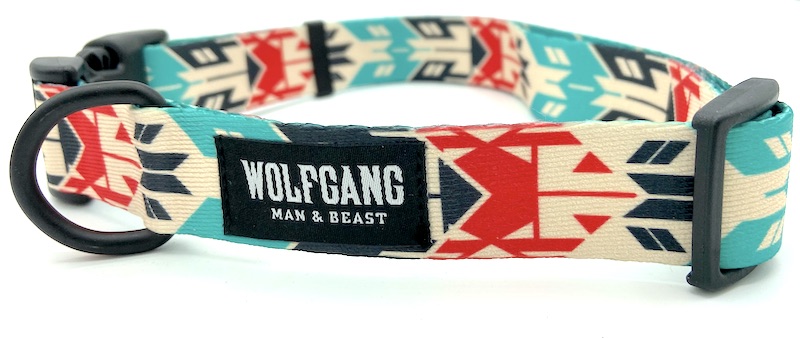
Collars boast abrasion-resistant polyester webbing and rounded nylon buckles, plus a heavy-duty steel d-ring with welded seams for ultimate durability.
They offer standard collars as well as martingale collars for those puppers who may try to back out of their collars on walks.
What We Love: These collars aren’t just a pretty face – they’re also made with solid materials that will stand up to even your most rigorous training sessions. We also have a deal with Wolfgang where you can get 10% off your order when you use K9OFMINE10 at checkout (on Wolfgangusa.com only)
The Downsides: The buckle may feel slightly bulkier than standard collar buckles, but it’s smooth edges and design make it supremely easy to secure.
The Best for Hard-to-Control Pullers
Puller Pick #1: Halti Optifit
This is a sponsored placement, in which an advertiser pays a fee to be featured in this article. Learn more
The Halti Optifit is one of the most well-known and popular brands of head halters around. While head halters can be a bit tricky to introduce properly to your pup, they’re hard to beat as far as the combination of safety and control.
If your dog is reactive, strong, and/or a major puller, consider purchasing a head halter for your dog.
Head halters give you more control over your dog’s movement and gaze because the leash clips to her muzzle.
It’s really important to avoid jerking on a head halter, since you could accidentally tweak your dog’s neck. It’s also key to ensure that you use a backup leash since head halters aren’t as secure as a harness or neck collar. This can lead to a lot of leashes to keep track of!
Read all about K9 of Mine’s head halter picks here!
What We Love: The Halti Optifit has reflective cheek straps. It’s also the most customizable head halter we can find on the market, making it the go-to for anything from whippets to mastiffs!
The Downsides: Head halters are strange and uncomfortable at first for most dogs, so be sure that you take the time to properly teach your pup to be comfy wearing this contraption! It can be a bit tricky to fit properly, so get help if you need. You also can’t leave the Halti Optifit on when you’re home, so you’ve got to remember to put it on and take it off again when you re-enter your house.
Puller Pick #2: 2 Hounds Design Freedom Harness
This is a sponsored placement, in which an advertiser pays a fee to be featured in this article. Learn more
I’m not generally the hugest fan of no-pull harnesses because of potential orthopedic issues, but the 2Hounds Design Freedom Harness is different.
Rather than having a strap that cuts across your dog’s shoulders, shortening her gait, the Freedom Harness is shaped by my beloved Y-shape design.
It also boasts a back-clip and front-clip option, allowing you to choose how you want to clip in depending on the situation. No-pull front-clip harnesses are a great way for you to feel in control on your walks without hurting your pup, and this harness offers a sturdy front-clip D-ring option.
In fact, 2 Hounds Design encourages users to make use of both attachment options at the same time for unparalleled canine control. Their Freedom Harness companion leash is made with two leash straps that allow you to clip to the front and back attachment points simultaneously.
If you’re looking for better control of your pup, definitely consider the harness + leash combo (they sell the 2 Hounds Freedom Harness + Leash set together, in addition to selling the two parts separately)
The 2 Hounds Freedom Harness is also unique in that it has a martingale loop on the back-clip attachment point. This means that, when pressure is put on the back clip, the harness will tighten slightly. This is just the thing for Houdini hounds who wriggle out of normal harnesses, as the slight constriction will prevent your pup from wriggling out.
Fans also appreciate that the belly strap is made with a soft velour fabric, helping to prevent armpit chafing. The harness also has several adjustment points, allowing you to get the perfect fit.
These harnesses are great for helping you to enjoy your walk and feel comfortable while you work on training your pup to walk politely!
What We Love: This harness includes two points of connection, allowing you to be extra secure using both clip options simultaneously (with the appropriate leash) or switch back and forth from front-clip to back-clip harness options. It also stands alone in the no-pull harness market as a harness that doesn’t restrict your dog’s movement. It comes in a variety of pretty colors, so you can ensure that your pup’s training proceeds in style.
The Downsides: Front-clip harnesses aren’t always intuitive to put on, and the Freedom Harness is no exception. Be sure to double-check that you’ve got the Freedom Harness on correctly, especially when first putting it on your pup.
As a front-clip harness, the Freedom Harness works by pulling your dog’s weight to the side. This reduces pulling strength but can be easily tangled and causes your dog to walk a bit diagonally if she keeps pulling.
The Best for Escape Artists
Houdini Hound Pick #1: Blueberry Pet Martingale Collar
This is a sponsored placement, in which an advertiser pays a fee to be featured in this article. Learn more
The Blueberry Pet Collar is a martingale-style dog collar. Also known as limited-slip or limited-cinch collars, martingales are great for dogs that slip their collars when excited or scared.
There are martingales available in full fabric or with a chain cinch. Unlike a choke collar, martingales only close to a pre-set size, so your dog can’t slip out of the collar but also won’t suffocate herself trying to pull!
What We Love: Martingales are great for skinny-headed dogs like smooth collies and sighthounds. I particularly love thick martingale collars for these breeds. They don’t choke your dog but also prevent your dog from wriggling out of your grasp. Plus, you can leave this collar on at all times and can use it as your main collar. This is great if you hate using a bunch of different pieces of equipment!
The Downsides: Martingales shouldn’t be used for dogs that pull hard on leash or for owners who jerk on the leash. The pressure on a dog’s thyroid glands and trachea is too risky. You’re better off with a Halti Optifit or a Freedom Harness if your dog is a major puller. This collar also doesn’t have any reflective strips and doesn’t different thicknesses options.
Houdini Hound Pick #2: Ruffwear WebMaster Harness
This is a sponsored placement, in which an advertiser pays a fee to be featured in this article. Learn more
Let’s face it. Some dogs are just Houdinis. But many Houdini hounds have met their match with the Ruffwear WebMaster Harness.
Rather than the traditional single strap behind your dog’s front legs, the WebMaster has two straps. This makes it nearly impossible to wiggle out of, making it a great escape-proof dog harness for those more sneaky, slippery pups.
What We Love: Ruffwear really knows their stuff when it comes to quality – their dog gear often tends to be the best or near the top on all canine equipment lists. This continues to be true for the WebMaster harness.
The WebMaster is easily one of the safest and sturdiest harnesses on the market. It’s reflective, hard to escape from, unlikely to break, and comes in a variety of colors. Definitely a hard one to beat!
The Downsides: Some dogs hate how the WebMaster slips over their head. If your dog is a bit uncomfortable with handling or new things near her face, the WebMaster can be pretty scary. Old and inflexible dogs might struggle getting their legs through the loops, since you have to help manipulate their legs into the correct position.
Best for Tiny Dogs
Petite Pooch Pick: The Wrap N Go Harness
This is a sponsored placement, in which an advertiser pays a fee to be featured in this article. Learn more
I said I don’t love harnesses with velcro closure, but the Wrap N Go Harness is the exception!
Its velcro closure is ultra-strong. One trainer I spoke to said it took two hands to take this collar off of her poodle!
The Wrap N Go is easy to use and comes in a variety of colors. If you’ve got a tiny dog who needs an extra-comfy harness, this is your answer.
What We Love: When you want comfort and safety for your tiny pup, this is your answer. The Wrap N Go has a velcro closure at both the neck and the chest, ensuring that tiny dogs can’t slip out as easily.
The Downsides: This harness doesn’t have many points of adjustment, instead relying on comfy stretchy fabric to fit your pup. That might make it more challenging for a super-skinny Italian greyhound or a chunky pug than some of the other options on the market. Some owners also had a hard time keeping their dog’s long hair out of the velcro. Ouch!
The Collar or Harness is a Tool, Not a Solution
Since we recommend using positive reinforcement and relationship-based training, we believe that you can do excellent dog training with any comfortable collar or harness.
However, remember that any collar or harness is simply a tool. No equipment is foolproof and failsafe, so we recommend using collars or harnesses as a stepping stone while you train your dog.
While you’ll never stop using your dog’s collar and/or harness entirely, you don’t want to rely on a fancy contraption to keep your dog under control!
Whether you’re working on polite loose leash walking, reactivity, or rally obedience, the tool is not the solution, but simply an aid in reaching a desired outcome.
Take loose leash walking for example, since many owners struggle with pulling dogs.
An owner may seek out a collar or harness that will prevent pulling. Using a tool like this can make your walks more manageable.
However, the goal should always be to train your dog to not pull on the leash (as demonstrated in the video below). A tool like an anti-pull harness is simply a band-aid temporary solution to use while you simultaneously work on training.
Still, when you’re starting out and just beginning to train your dog, having equipment that is safe, comfortable, and provides you with adequate control over your dog can make the training process much smoother.
Features to Look for in the Best Harnesses and Collars for Dog Training
What to look for in your training collar or harness:
1. Comfort For Your Dog
It’s much harder to learn when you’re afraid, in pain, or just uncomfortable. That means that one of the biggest things to look for in your best dog training collar or harness is comfort.
The type of collar or harness you enlist may vary depending on the breed of your dog. Most short-nosed breeds like pugs and boxers should always be walked on a harness, since their breathing is already made difficult by a shortened nose. Collars can further exacerbate breathing issues.
Meanwhile, narrow-headed dogs like greyhounds and collies are best served by a martingale-type collar or harness since traditional collars may be too loose.
All dogs should have freedom of movement in their shoulders, meaning that harnesses with straps across the dog’s chest or shoulders are often a no-go. Avoid harnesses that rub in your dog’s armpits or across their chests.
Adjustability and personalization are key here. Many of our top picks are highly customizable, with several points of adjustment to ensure that you can get a perfect fit for your English bulldog, whippet, and cane corso!
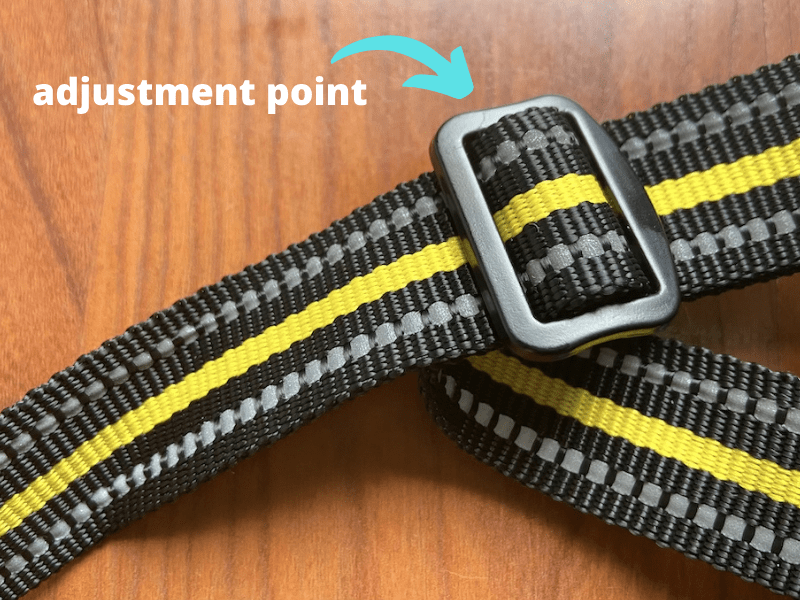
Most modern dog trainers, veterinary behaviorists, and animal behavior consultants strongly recommend staying far away from training contraptions that can cause pain or discomfort for your dog such as choke, prong, or e-collars.
They especially discourage these collars for beginner trainers and/or as a first line of defense for training your dog.

2. Ease Of Use For You (The Owner)
If I’ve learned one thing in my years of working with dog owners, it’s that training has to work for both the dog and the owner.
If you hate putting on your pup’s harness, you’re likely to either skip the harness or the walk. It’s best to try on a harness before buying it to confirm that it works for your dog and that you feel confident getting it on and off your pup easily.
The same goes for choosing a leash – get a solid dog leash that’s comfortable for you and provides all the features you need.
3. Excellent Fit
Even the best dog harness or collar is only great if it fits your dog properly.
Be sure to measure your dog before ordering a harness online. Check out Chewy’s video below that shows how to measure for a collar or harness.
Keep in mind that different harnesses require different measurements depending on how they sit on your dog – so check the specific product first!
It can be a pain to pull out the measuring tape, but it’s worth it to avoid hot spots or escapes if the fit is off.
It’s also a good idea to check out breed-specific sites and reviews of harnesses, since dogs come in so many shapes and sizes. If you’re really concerned about fit, going into a store is your best bet to get that perfect fit.
Many dogs are easy to fit for harnesses – labs, cattle dogs, and other popular mid-sized to large breeds are a piece of cake. The trouble comes when your dog is one of the more “extreme” body shapes, like sighthounds, mastiffs, or very stocky breeds.
Take extra care with fit if your dog falls into one of these categories.
4. Safety
While comfort and proper sizing is a big part of safety, there are other added safety factors you’ll want to consider when harness or collar shopping.
A few of the highlights I look for include:
Increased Visibility
I love dog training harnesses and collars that have reflective panels or glow-in-the dark features. These help keep your pup safe during low-light walks, even if you’re on a sidewalk or bike path.
Cyclists, walkers, and other dog walkers can see your dog more easily using these features, which keeps everyone safe and happy.
If you can’t find a harness or collar with built-in visibility features, you can just purchase a light for your dog’s collar or harness.
Quick Release Buckles
Having a quick release option is really valuable to ensure that there’s an easy way for you to remove your dog’s collar quickly if your dog gets caught on a bush, a crate, or another dog.
While I’ve never seen it personally, I’ve heard of tragedy when collars get tangled during play or rest. Almost any snap-type collar is considered quick release, while a belt-buckle-style collar is not.
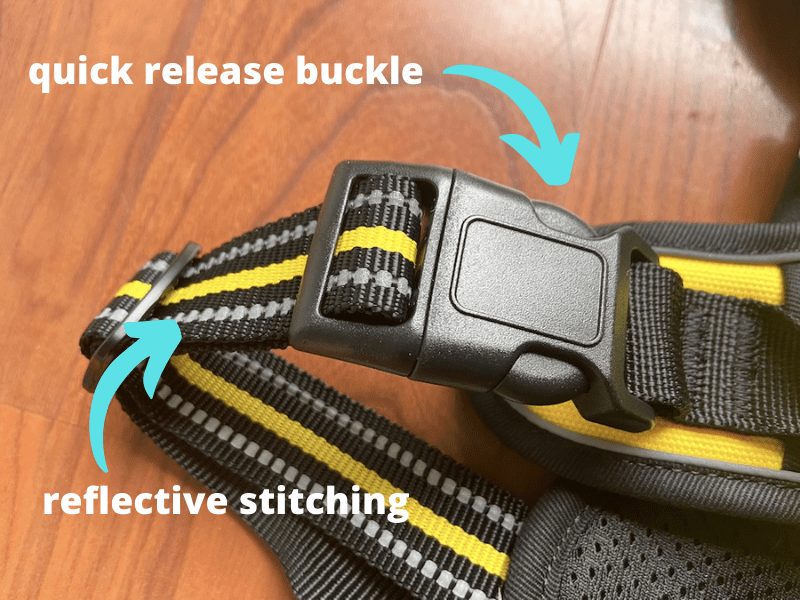
Sturdiness
If your dog is reactive, doesn’t come when called, or could decide to run away from a scary trigger, you don’t want a collar that could break or slip off. This is why I’d never recommended a collar or harness that stays on using something flimsy like Velcro for a dog over 25 pounds!
It may seem a bit confusing to say that you want to look for a sturdy collar that also has a quick release. What you really want is extreme durability and sturdiness, with a solid emergency parachute in case things go wrong!
Belt buckle-type collars are less likely to break when your dog lunges or tries to pull away, but they’re also nearly impossible to get off your pup in a pinch.
Weigh the options carefully when selecting which collar to buy and when to take your dog’s collar off.
Handle
While it’s not essential, some harnesses will include handles on the top, which can be handy when you need a bit more control.
Handles are also handy when you need to lift your dog over difficult terrain during hikes, or when they a bit of help getting up stairs (although for arthritis in the back legs, lift harnesses are a more suitable option).
Do I Want a Collar or a Harness for Training My Dog?
Many trainers say that collars are for decorative purposes and are a great way to hold identification tags. These trainers prefer to train dogs on a harness – and I agree! For many owners, harnesses will be the way to go.
Other excellent trainers firmly believe that it’s not the equipment that matters, but the training done between the dog and owner. Either way, most of the best dog equipment for training fall into the harness bucket rather than collar category.
In general, I prefer to work with dogs using a back-clip Y shaped harness while they’re still in training.
The benefits of a back-clip Y shaped harness include:
- Doesn’t reduce oxygen availability for your dog. Any neck collar that makes your dog gasp is not a good choice for training! As mentioned, this is especially important for short-nosed breeds, but is generally a good rule for all dogs.
- Doesn’t press on your dog’s thyroid glands. Pressure on thyroid glands from dogs that pull hard on neck collars or are given frequent leash corrections with a collar has been linked to thyroid issues. To make matters worse, thyroid issues are closely linked with aggression. It’s really important to teach your dog not to pull and to avoid leash corrections if you want to reduce the chance of your dog developing thyroid issues and (potentially) aggression!
- Doesn’t interfere with your dog’s range of motion. Many front-clip harnesses have a strap that goes across the front of a dog’s chest or the top of her shoulders. These straps can shorten or change your dog’s gait, which can lead to joint issues down the line. Front clip harnesses can be lifesavers for dogs who pull, but aren’t the right choice for all dogs – especially if your dog doesn’t have a yanking issue. Read more about the pros and cons of front-clip harnesses here at Whole Dog Journal.
- Less leash-tangling. Many of my clients report that their pups get tangled in the leash less often when using a back-clip harness when compared to a front-clip harness or collar.
On the other hand, one of the biggest downsides of a back-clipped Y shaped harness is that it allows your dog to really pull hard if they want. That’s where some of our other recommendations come in handy!
It’s really best in the long-term to teach your dog not to pull, rather than to rely on equipment and contraptions to reduce her strength.
Still, when you’re starting off, it can be handy to have a harness that prevent pulling – especially if you’re dealing with a strong pooch!
There are thousands of different collars and harnesses out there. Using the right training, almost any collar or harness is great for training your dog. Just remember that it’s the human who trains the dog, not the equipment.
Take the time to find a collar or harness that fits well and keeps everyone safe, then get out your treats and start training!
Do you have any favorite harnesses or collars you use with your dog? Share your top picks in the comments!
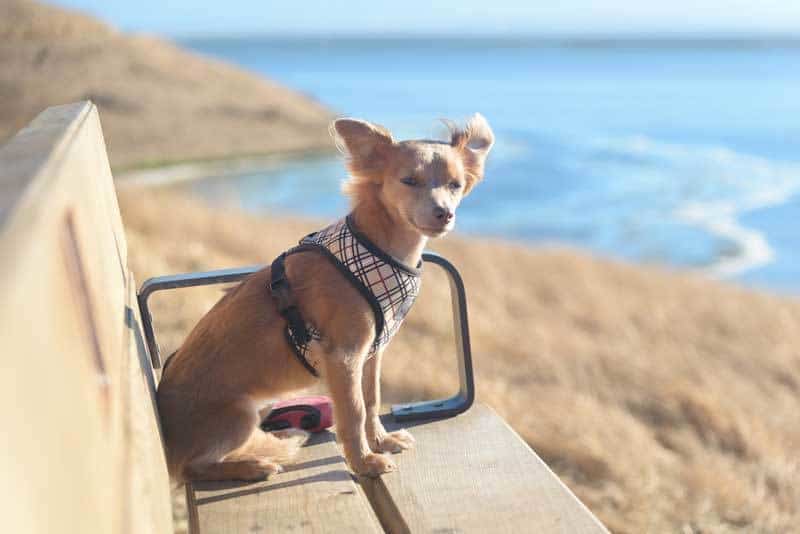











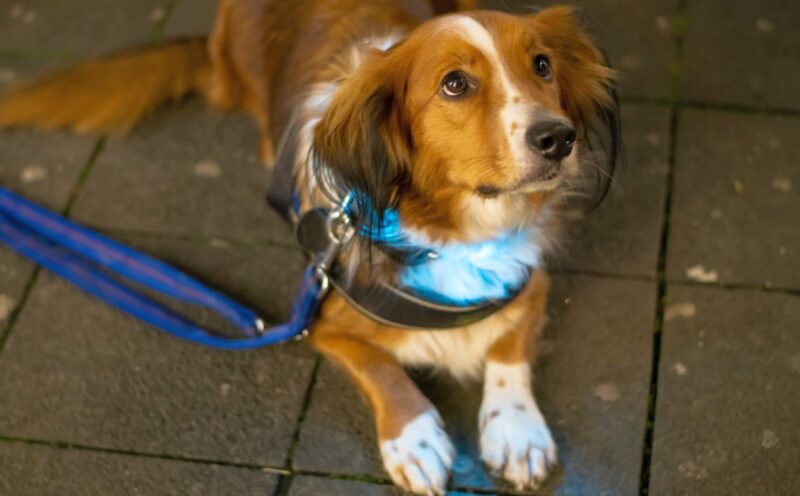
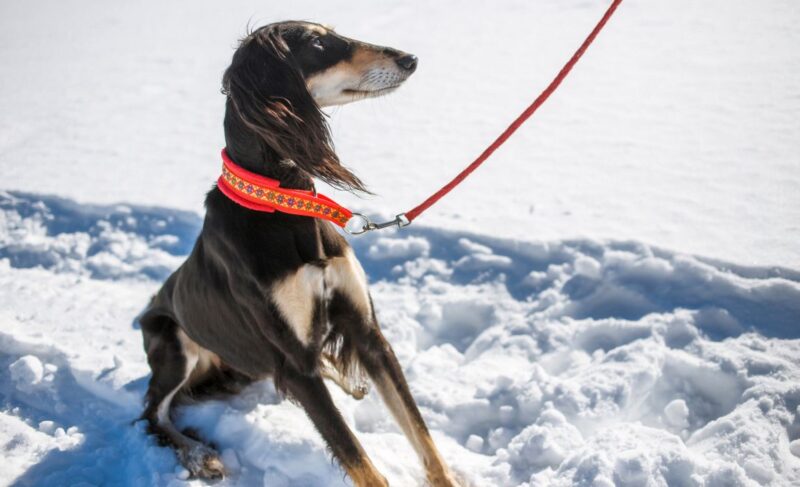
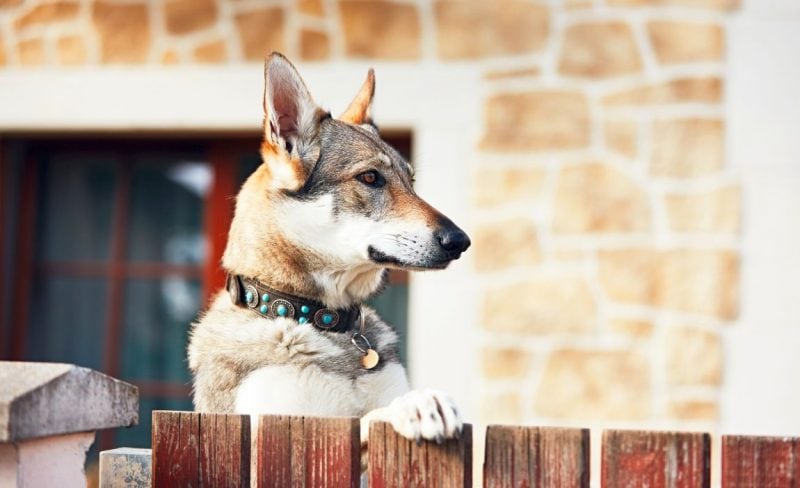

Leave a Comment